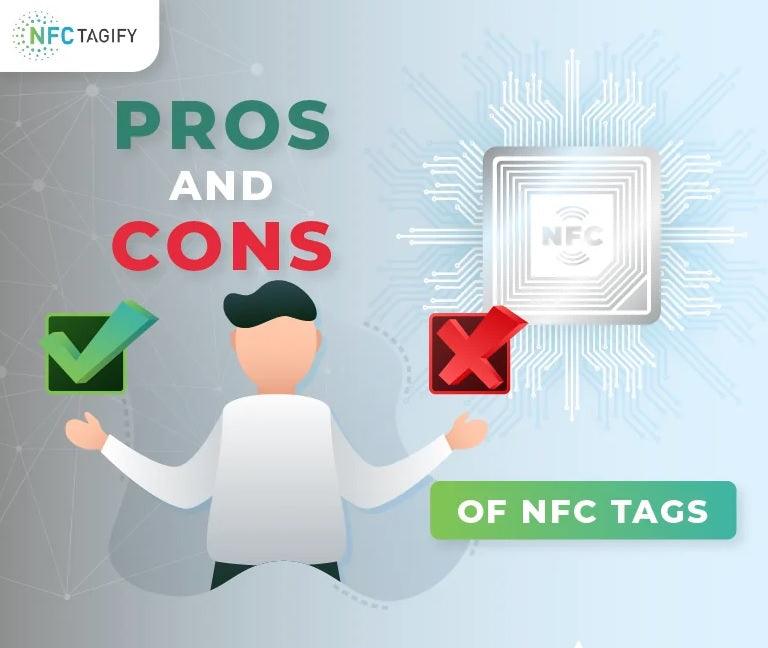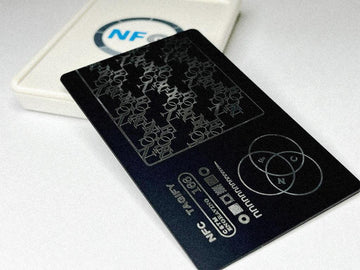Pros and Cons of NFC Tags - Infographic


Advantages of NFC Tags
NFC tags have multitudes of advantages for their users, ranging from security matters to simple ease of use. Among them are the following:
Strong Security
Businesses can use NFC tags to improve their security by programming the tags to contain identity documents and data to verify someone’s identity. The tag can contain data on passports and IDs to confirm one’s identity after a single tap. This is in line with the shift of NFC usage from simple tap-to-pay to tap-to-identify functions. Companies can use NFC tags for security purposes by installing NFC door locks in the office and assigning cards to authorised personnel to prevent thieves from breaking and entering. Even homeowners can use tags for this purpose.
Ease of Use
NFC transactions are fast and seamless since people only need to tap their smartphone to another NFC-enabled device. This essentially speeds up transactions and customer validation while reducing manual errors, effectively boosting efficiency and improving customer satisfaction. NFC tags make life easier for many people due to the technology's convenience. When using NFC cards for contactless payment, cardholders only need to tap their card to pay. Even people who don't have cards can benefit from NFC technology if they use NFC-enabled smartphones and go to stores where NFC stickers are used for contactless payment. This is true thanks to Apple Pay and Google Pay.
Short Setup Time
Anyone can easily get started with using NFC technology, regardless of whether they’re Android or iPhone users. Android users only need to go to the following: Settings -> Share & Connect -> NFC iPhone users only need to go to Communication settings to access the NFC setting. Many people also program their own NFC stickers and use custom smart cards for specific functions. All they need is a supply of rewritable stickers, an NFC reader, and an app dedicated to programming tags.
Versatility
It’s mentioned above that NFC is versatile. Its versatility is practically limitless, and many people and businesses can program tags to serve a wide range of purposes. Some amazing uses of NFC stickers that people can flaunt to their friends include setting timers, activating alarms, and activating certain functions with a tap while driving. Tech enthusiasts can even program their NFC tags to automate their homes, including automating the lights and temperature. Imagination and the supply of NFC stickers is the only limit to how much someone can customise their tags.
Lower Battery Consumption
NFC is more energy-efficient than other data transfer methods, especially since it only takes a tap to conduct a transaction. Anyone who wants to reduce their carbon footprint should consider taking full advantage of NFC tech.
Disadvantages of NFC Tags
NFC technology may have multitudes of advantages for users, but using this tech also comes with different risks and disadvantages and among them are the following:
High Cost
Using and customising NFC tags involves purchasing the tags themselves, metal or wooden cards when customising NFC cards, and getting an NFC reader to program the stickers. The cost may be relatively insignificant for an individual user, but the scale goes up for businesses. NFC-enabled biometrics is a relatively new technology that requires the use of NFC-enabled smartphones and NFC readers to customise tags. Businesses that want to adopt the technology either need to issue NFC-enabled smartphones to their employees or invest in custom smart card printing to assign their employees with NFC cards. Stores can’t immediately adopt NFC technology and replace their payment methods with contactless because the average customer won’t likely have enough money to get a costly NFC-enabled smartphone.
Being a New Vector for Fraud
Hackers always seek ways to exploit different vulnerabilities to compromise different organisations’ security and scam people off their money. The popular NFC technology is popular with both tech enthusiasts and fraudsters, with the latter using the technology through the following:- ATM card skimming
- NFC poster skimming
- NFC relay attack
Cybercriminals can skim ATM cards by using custom NFC card readers to steal information before the machine's card reader can read it. They can also print fake advertisement posters with embedded NFC stickers to transmit malware or harmful apps to a device. It’s also possible to clone NFC cards to compromise security features reliant on them. NFC cards aren't that secure, so people should practice due diligence to protect themselves from cybercriminals. Businesses should also only use NFC for identity verification when using it as part of a two-factor authentication solution.
Limited Range
Based on the name alone, people can’t use NFC cards when the NFC-enabled device is too far from the sticker. The tag and device will refuse to establish a connection when the distance is more than 4 cm or a few inches. Bluetooth and WiFi will be better methods to transfer data in such cases.
Low Data Transfer Rate
Despite the advantages of NFC, it has a slow transfer speed of 400 Kbit/s, so its use is limited despite being a versatile piece of tech. People won't be able to transfer large video files. However, they can direct people to certain websites and web pages, so it's still possible to share media, but only when the recipient is connected to the internet.









